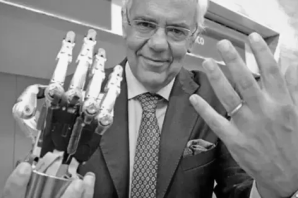From pizza maker to physiotherapist: Italian robot's promising skills
Why should people waste their time executing some repetitive time-consuming everyday tasks which do not require creativity and intellectual capacity? Such a reasoning stands behind Professor Bruno Siciliano’s ERC funded project aiming at the creation of a new generation of service robots.

The Naples region does not only host Mount Vesuvius, it is also the home of a worldwide renowned laboratory in robotics, the PRISMA Lab. It is headed by Prof. Bruno Siciliano, an expert in robotics, author of several bestsellers and former president of the most important professional association in the field.
Bruno Siciliano is a son of the Neapolitan soil. He obtained his PhD from the University of Naples Federico II in 1987 and then became Professor at the same University. The idea of a robot making pizza naturally came to his mind. “Beyond the real technical challenge, it is also a way to honour and keep track of a tradition. I have colleagues in Japan who have developed robots able to reproduce ancestral dances. Cultural heritage plays a role in robotics, and vice versa”, he explains.
Dexterous, mobile and safe
RoDyMan – the acronym for Robotic Dynamic Manipulation – is a service robot that will be able to mimic complex human tasks with a level of dexterity and mobility never seen before. “The manipulation of non-rigid, deformable objects – food or clothes in our daily lives, soft tissues such as muscles and skin in medical operations – has not been much investigated so far and offers an important challenge to the robotics community”, comments Prof. Siciliano. RoDyMan will be composed of a torso, two lightweight arms and multi-fingered hands. It will not have legs but it will be rather mounted onto an omni-directional platform with wheels. Its head will be equipped with a stereo camera system and a structured lighting set up. It will have proximity and range sensors, as well as tactile sensors.
Interaction with humans is at the core of the project. “For this reason, safety is a key feature of the new system”, says Prof. Siciliano. “This autonomous robot should be able to control the flow of events in the task, react to and learn from its environment. It will be able to deal quickly with unexpected situations, such as the presence of humans or obstacles”.
Ready in five years
The project is at the crossroad of different disciplines, involving not only mechanics and engineering but also cognitive science and artificial intelligence. As a result, Prof. Bruno Siciliano’s team represents different profiles. “With the ERC grant, I plan to hire four Post-Docs and three PhD students, who will tackle the challenge of tossing the pizza dough and turn the peel into the oven by using a mobile dual-arm/hand robotic platform”, he explains.
At a later stage, this robot might be in your home, helping you with your daily tasks. “Service robots are tomorrow’s computers”, says Bruno Siciliano. The demand is continuously increasing. According to data of the International Federation of Robotics, about 2.5 million service robots for personal and domestic use were sold in 2011, 15% more than in 2010. “The ageing population will drive the application of robotic technologies that improve the quality of life and assist people to live longer and more comfortably in their houses”, continues Prof. Siciliano. Applications in the medical field, notably in physiotherapy, can also be foreseen.
In the next five years, RoDyMan’s challenge is to make pizzas. Asked whether they will be as tasty as those of Neapoletan pizzaiolos, Bruno Siciliano answers “That is nearly impossible! Yet we will involve one of the best pizzaiolos in town and learn the skilled and artistic movements directly from him through the use of a biokinetic sensorised wearable suite and a 3D motion capture system”. The degustation is planned in 2017.


